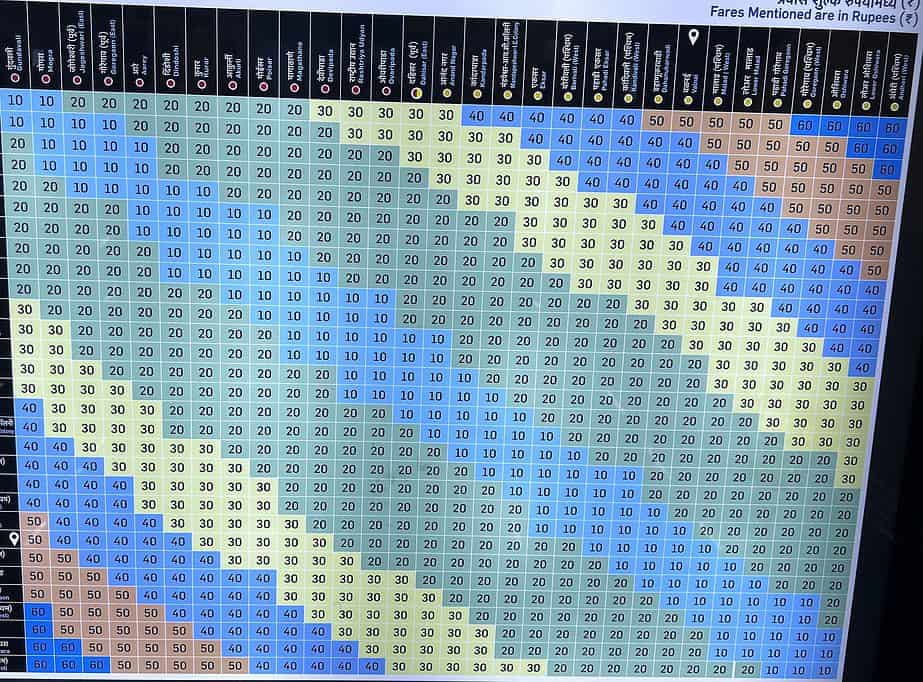
Mumbai Metro Dahisar to Andheri – The Maharashtra government has flagged off the much-awaited Metro Line from Dahisar to Andheri on the western side of Mumbai. The train is fully automatic, and the stations are modern class.
This service is expected to reduce travel time by 50% to 75%, depending on the road traffic conditions.
Both lines 2A and 7 are interconnected at Dahisar. The first 3 coaches are for Ladies.
Mumbai Metro Route Line – Dahisar to Andheri West -Line 2A
- Metro Line 2A from Dahisar to D N Nagar is 18.6 km. Distance elevated metro with 17 stations.
- It will provide connectivity with Metro Line 1 (Ghatkopar to Versova), the ongoing Metro Lines 2B (D N Nagar to Mandale) and 7 (Andheri East to Dahisar East), and the Metro Line No. 6 (Swami Samarth Nagar to Vikhroli).
| Station Name |
| Dahisar East |
| Anand Nagar |
| Kandarpada |
| Madapeshwar I.C Colony |
| Eksar |
| Borivali West |
| Pahadi Eksar-Shimpoli |
| Kandivali West |
| Dhanukarwadi |
| Valnai Meeth Chowky |
| Malad West |
| Lower Malad |
| Bangur Nagar |
| Goregoan West |
| Oshiwara |
| Lower Oshiwara |
| Andheri West DN Nagar |
Mumbai Metro Route Line – Dahisar East to Gundavali (Andheri East) – Line 7
- Metro Line 7 from Andheri East to Dahisar East is 16.5 km. Distance long elevated corridor with 13 stations
- It will provide interconnectivity among the existing Western Express Highway (WEH), Metro Line 1 (Ghatkopar to Versova), the Metro Line 2A (Dahisar to D N Nagar), and the Metro Line 6 (Swami Samarth Nagar to Vikhroli).
| Station Name |
| Dahisar East |
| Ovaripada |
| Rashtriya Udyan |
| Devipada |
| Magathane |
| Poisar |
| Akurli |
| Kurar |
| Dindoshi |
| Aarey |
| Goregaon East |
| Jogeshwari East |
| Mogra |
| Andheri/WEH/Gundavali |
Mumbai Metro Line 1 Versova-Andheri-Ghatkopar Route
- Versova-Andheri-Ghatkopar corridor is an 11.40 km distance elevated metro.
- It connected the Eastern and Western suburbs with the Western and Central Railways.
- Facilitates smooth interchange between the suburban railway and MRT System at Andheri and Ghatkopar Stations.
- Journey time was reduced from 71 minutes to around 21 minutes between Versova and Ghatkopar.
- It enabled rail-based service to the MIDC, SEEPZ, and commercial areas.
| Station Name | Status |
| Versova | Operational |
| D N Nagar | Operational |
| Azad Nagar | Operational |
| Andheri | Operational |
| Western Express Highway | Operational |
| Chakala JB Nagar | Operational |
| Airport Road | Operational |
| Marol Naka | Operational |
| Saki Naka | Operational |
| Asalpha | Operational |
| Jagruti Nagar | Operational |
| Ghatkopar | Operational |
| First Metro | 06:30 AM |
| Last Metro | 10:30 PM |
| Travel Time | 30 Min |
| Travel Distance | 15 KM |
| Total Stations | 11 Stops |
Cost for the journey at Metro 2A and 7:

Fare for Travel in Mumbai Metro
| Distance Km | Single Journey |
|---|---|
| 0-3 | Rs. 10 |
| 3-12 | Rs. 20 |
| 12-18 | Rs. 30 |
| 18-24 | Rs. 40 |
| 24-30 | Rs, 50 |
| 30- 36 | Rs. 60 |
| 36-42 | Rs. 70 |
| >42 | Rs, 80 |
Last train timing :
- Andheri West to Dahisar East train at 10:30 p.m.
- Gundavali to Dahanukarwadi via Dahisar East at 10:30 pm.
How to book the ticket :
There are 3 ways to book the ticket. The staff issuing the ticket are very friendly and professional.
- Ticket counter – There is at least 2 ticket counter at every station. You can mention your destination and book your ticket with cash.
- SBI Mumbai Metro – You can apply for a Mumbai Metro card at the counter at any station. You must fill out a form and provide ID proof like a Driving license, PAN Card, or Aadhar card and a one-time top-up of Rs. 100 and top up in multiples of Rs.100 after that. The global transit limit is Rs.2000. tap your card at the entry barrier and move towards taking your metro; it is simple.
- Ticket Vending Machine – There are many ticket vending machines at every station, but I found more non-operational.
Mumbai (formerly Bombay) is a heavily populated metropolis on India’s west seaside. A financial hub, it’s India’s biggest city. On 16 April 1853, India’s foremost train started its operation. Mumbai trains are the busiest railways globally, carrying approximately 2.2 billion passengers yearly.
The current addition of this metro will enable Mumbai to interconnect between Western and Central Mumbai and help passengers reach their destination in the shortest possible time. Mumbai Railways is the most economical and fastest mode of transport compared to road travel, hence the preferred choice of travel by most Mumbaikars.
Leave a Reply